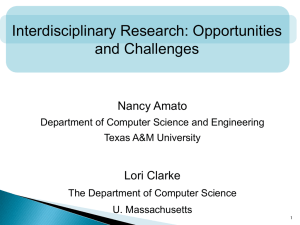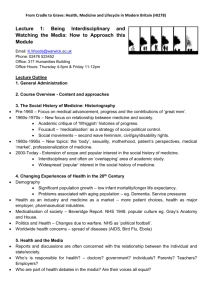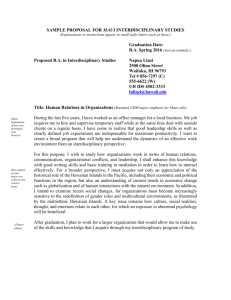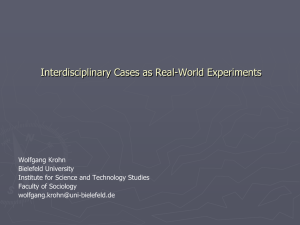CIED 5293 - University of Arkansas
advertisement
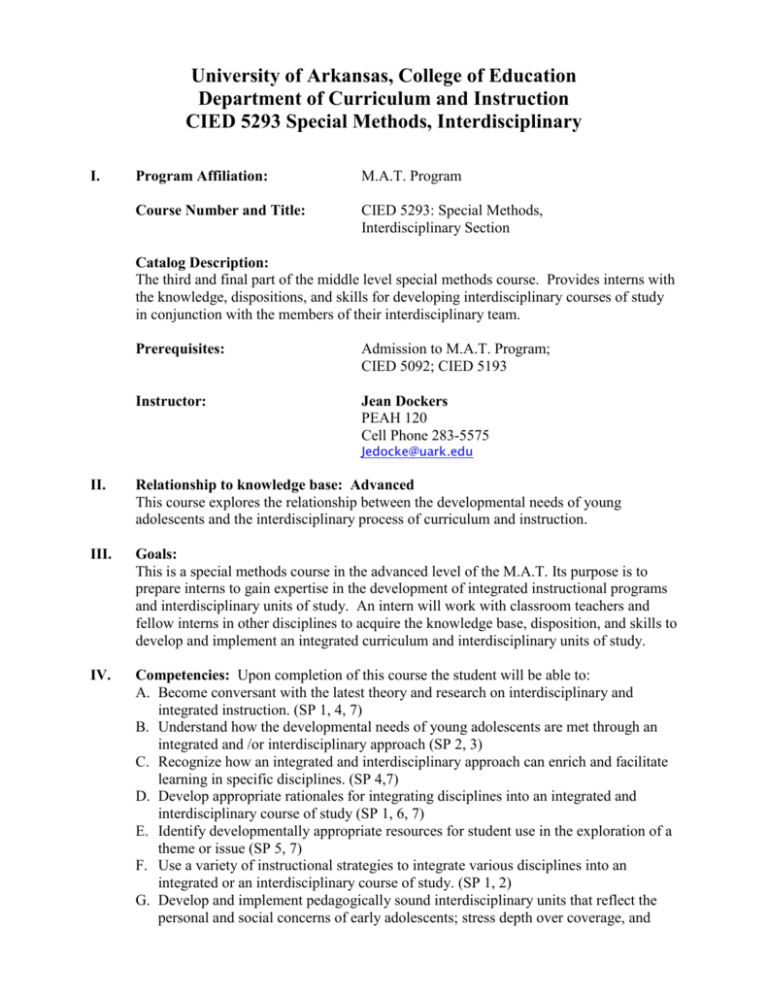
University of Arkansas, College of Education Department of Curriculum and Instruction CIED 5293 Special Methods, Interdisciplinary I. Program Affiliation: M.A.T. Program Course Number and Title: CIED 5293: Special Methods, Interdisciplinary Section Catalog Description: The third and final part of the middle level special methods course. Provides interns with the knowledge, dispositions, and skills for developing interdisciplinary courses of study in conjunction with the members of their interdisciplinary team. Prerequisites: Admission to M.A.T. Program; CIED 5092; CIED 5193 Instructor: Jean Dockers PEAH 120 Cell Phone 283-5575 Jedocke@uark.edu II. Relationship to knowledge base: Advanced This course explores the relationship between the developmental needs of young adolescents and the interdisciplinary process of curriculum and instruction. III. Goals: This is a special methods course in the advanced level of the M.A.T. Its purpose is to prepare interns to gain expertise in the development of integrated instructional programs and interdisciplinary units of study. An intern will work with classroom teachers and fellow interns in other disciplines to acquire the knowledge base, disposition, and skills to develop and implement an integrated curriculum and interdisciplinary units of study. IV. Competencies: Upon completion of this course the student will be able to: A. Become conversant with the latest theory and research on interdisciplinary and integrated instruction. (SP 1, 4, 7) B. Understand how the developmental needs of young adolescents are met through an integrated and /or interdisciplinary approach (SP 2, 3) C. Recognize how an integrated and interdisciplinary approach can enrich and facilitate learning in specific disciplines. (SP 4,7) D. Develop appropriate rationales for integrating disciplines into an integrated and interdisciplinary course of study (SP 1, 6, 7) E. Identify developmentally appropriate resources for student use in the exploration of a theme or issue (SP 5, 7) F. Use a variety of instructional strategies to integrate various disciplines into an integrated or an interdisciplinary course of study. (SP 1, 2) G. Develop and implement pedagogically sound interdisciplinary units that reflect the personal and social concerns of early adolescents; stress depth over coverage, and critical and creative thinking over rote memorization; and engage the students’ multiple intelligences. (SP 2, 3, 6, 7) H. Develop and implement interdisciplinary units in which the various disciplines are synergistically interwoven. (SP 1, 2) I. Develop dispositions, knowledge base, and the skills to construct interdisciplinary units with members of an interdisciplinary team. (SP 1, 2, 5) V. Content: A. Unique needs of early adolescents and their relationship to developmentally appropriate instructional methods. B. Developmentally appropriate instruction 1. Research on Learning 2. Meeting the unique needs of early adolescents 3. Focusing on personal and social concerns of early adolescents 4. Adjunct instructional issues a. Intellectual risk is not only acceptable but also encouraged. b. Working individually, in small groups, in whole groups c. Connecting new information to what is already known d. Content area teachers are committed to teaching students and not just content 5. Developmentally appropriate instructional methods a. Think-Pair Share b. Cognitive mapping c. Cooperative learning d. Experiments e. Interviews and Surveys f. Individual and group projects g. Other appropriate strategies C. Methods for developing instructional units via interdisciplinary team organization. 1. Taking into consideration the personal and social concerns and interests of early adolescents 2. Delineating each team member’s quarter and/or semester’s curriculum 3. Trying the curriculum to state and discipline standards 4. Brainstorming with team members 5. Developing a cognitive mat of the team’s plan 6. Collecting resources for the unit 7. Developing the interdisciplinary unit; fusing the content of the various disciplines 8. Analyzing for curriculum articulation 9. Developing a timeline for implementation 10. Developing a team approach for evaluating the curriculum D. implementing interdisciplinary units and/or an integrated curriculum via interdisciplinary team organization E. Evaluating the program/unit 1. Traditional Assessment 2. Alternative assessment (authentic and multiple-intelligences based) 3. Portfolio based. VI. Evaluation Presentations Classroom participation Integrated Unit Lesson Plans Interdisciplinary Teacher Resource Binder Reflective Journal Mid-term and Final Assessment VII. Grading Scale: A= 100-90 B= 80-89 C=70-79 D=60=69 F=Below 60 VIII. Miscellany: Academic Honesty: The University of Arkansas Academic Honesty Policy, as stated in the Graduate School Catalog, will be fully adhered to in this course. Grades and degrees earned by dishonest means devalue those earned by all students; therefore,, it is important that students are aware of the University of Arkansas Academic Honesty Policy. Academic dishonesty involves acts which may subvert or compromise the integrity of the educational process. Cell Phones and Pagers: Students are to turn off all cell phones and pagers before entering the classroom. Inclement Weather: The instructor of this course will follow the inclement weather policy of the University of Arkansas. If school is closed due to weather it will be posted on the web site. IX. Course Resources; A. University Libraries B. Textbooks C. Mentor teachers D. Instructor E. Instructors’ personal library F. Fayetteville Public Library G. Professional journals H. Media/technology I. Field experiences X. Research Base: Textbooks: 1. The Interdisciplinary Teacher’s Handbook: Integrated Teaching Across the Curriculum. By Stephen Tchudi and Stephen Lafer Boynton/Cook Publishers, Inc. (1996) ISBN 0-86709-398-6 $ 34.50 2. How to Assess Student Work By Lida Lim Prentice Hall (1997) ISBN 0-13-433908-8 http://www.phschool.com $ 20.97 Also: Please purchase ONE of the following in your content area 3. Integrating Instruction in Social Studies: Strategies, Activities, Projects, Tools, and Techniques By Imogene Forte and Sandra Schurr (1996) ISBN 0-86530-320-7 http://www.incentivepublications.com/catalog.htm $ 15.95 4. Integrating Instruction in Math: Strategies, Activities, Projects, Tools, and Techniques By Imogene Forte and Sandra Schurr Incentive Publications (1996) ISBN 0-86530-322-3 http://www.incentivepublications.com/catalog.htm $15.95 5. Integrating Instruction in Science: Strategies, Activities, Projects, Tools and Techniques By Imogene Forte and Sandra Schurr Incentive Publications (1996) ISBN 0-86530-321-5 http://www.incentivepublications.com/catalog.htm $15.95 6. Integrating Instruction in Language Arts: Strategies, Activities, Projects, Tools and Techniques By Imogene Forte and Sandra Schurr Incentive Publications (1996) ISBN 0-86530-323-1 http://www.incentivepublications.com/catalog.htm $15.95 References Anderson, E., Blaney, N., Stephan, C., Sikes, J., & Snapp, M. (1998). The Jigsaw Classroom. Beverly hills, CA: Sage. Atwell, N. (1987) In the middle: Writing, Reading, and learning with Adolescents. Portsmouth, NH: Boynton/Cook. Beane, J. (1991). “The Middle School: Natural Home of Integrated Curriculum.” Educational Leadership. 49 (2); 9-12 Beane, J. (1996). “On the Shoulders of Giants! The Case for Curriculum Integration.” Middle School Journal. 28 (1): 6-11. Bransford, J.D., Brown, A.L., & Cocking, R.R. (Eds). (2000). How People Learn: Brain, Mind, Experience, and School. Washington D.C.: National Academy Press Brophy, J. and Alleman, J. (1991). “ A Caveat: Curriculum Integration Isn’t Always a Good Idea.” Educational Leadership. 49 (2): 66 Cohen, E. (1986). Designing Groupwork: Strategies for the Heterogeneous Classroom. New York: Teachers College Press Clark, J. (1994). “Pieces of the Puzzle: The Jigsaw Method.” In Handbook of Cooperative Learning methods, Sharan, S., (ed.) Westport, CT: Greenwood Press. Cornett, C.E. (1999). The arts as meaning makers. Upper Saddle River, NJ: Merrill. George, P. 91996). “The Integrated Curriculum: A Reality Check.” Middle School Journal. 28(1): 12-19. Jacobs, H.H., (ed.).(1989). Interdisciplinary Curriculum: Design and implementation. Alexandria, VA: Association for Supervision and Curriculum Development. Kellough, R.D., Cangelosi, J.S., Collette, A.T., Chiappetta, E.L., Souviney, R.J., Trowbridge, L.W., & Bybee, R.W. (1996). Integrating mathematics and science for intermediate and middle school grades. Englewood Cliffs, NJ: Merrill. Lafer, S., and Tchudi, S. (1993). “How Dry Is the Desert: Nurturing Interdisciplinary Learning.” Educational Leadership. 51: 76-79. Lafer, S., and Tchudi, S. (1994). “The Familiar Made Curious; The Case for Hometown Interdisciplinary Studies.” The English journal. 83: 14-20. Lounsbury, J. (1996). “connecting the curriculum through interdisciplinary instruction.” Middle School Journal. 28 (1): 3-5. Olshansky, B. (1990). Portfolio of illustrated step-by-step art projects for young children. New York; Center for Applied Research in Education. Vars, G. (1991). “Integrated Curriculum in Historical Perspective.” Educational Leadership. 49 (2): 14-15. Williams, J, and Reynolds, T.D. (1993). ‘Courting controversy: How to build interdisciplinary Units.” Educational leadership. 50 (7): 13-15



